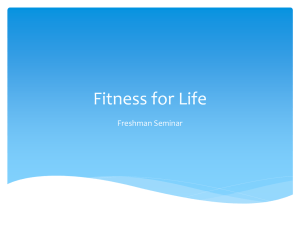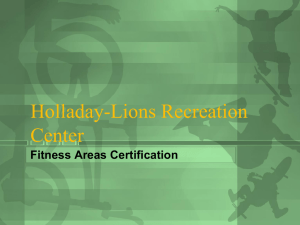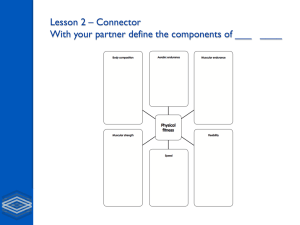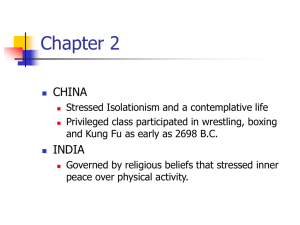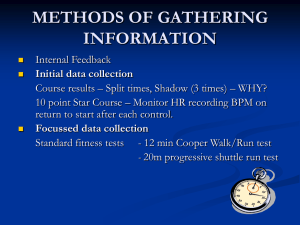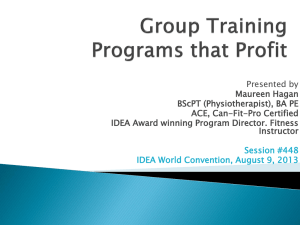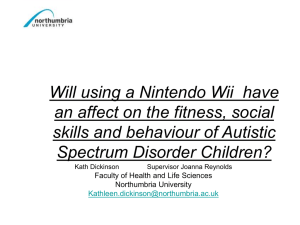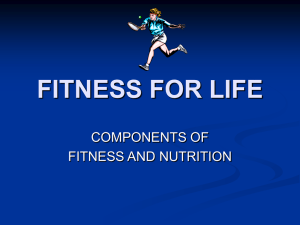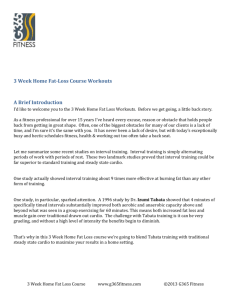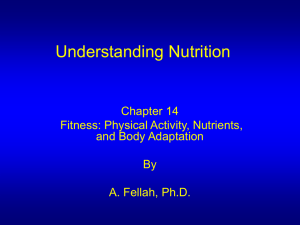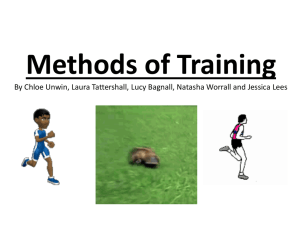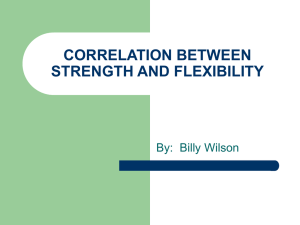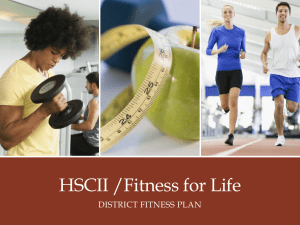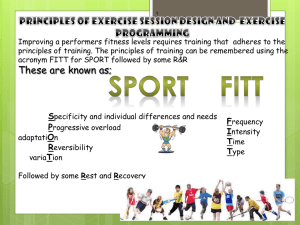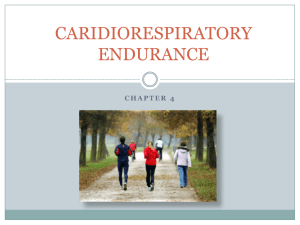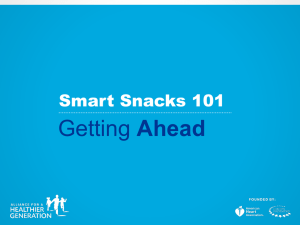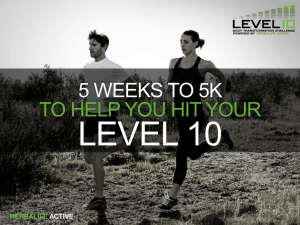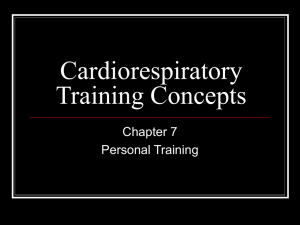Fitness Powerpoint
advertisement
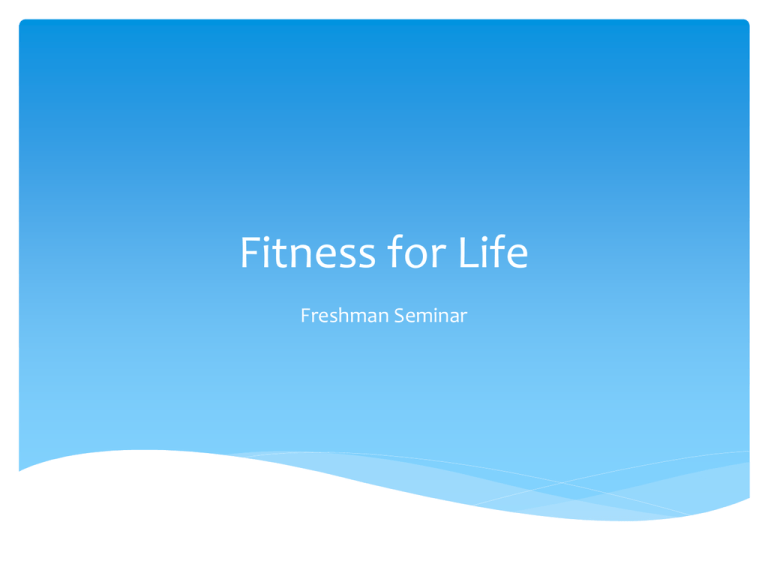
Fitness for Life
Freshman Seminar
Why exercise?
Benefits of regular physical activity
1: Exercise controls weight
Exercise can help prevent excess weight gain or help
maintain weight loss. When you engage in physical activity,
you burn calories. The more intense the activity, the more
calories you burn. You don't need to set aside large chunks of
time for exercise to reap weight-loss benefits. If you can't do
an actual workout, get more active throughout the day in
simple ways — by taking the stairs instead of the elevator or
revving up your household chores.
Benefits to exercise
2: Exercise combats health conditions and diseases
Worried about heart disease? Hoping to prevent high blood
pressure? No matter what your current weight, being
active boosts high-density lipoprotein (HDL), or "good,"
cholesterol and decreases unhealthy triglycerides. This
one-two punch keeps your blood flowing smoothly, which
decreases your risk of cardiovascular diseases. In fact,
regular physical activity can help you prevent or manage a
wide range of health problems and concerns, including
stroke, metabolic syndrome, type 2 diabetes, depression,
certain types of cancer, arthritis and falls.
Benefits to exercise
3: Exercise improves mood
Need an emotional lift? Or need to blow off some steam
after a stressful day? A workout at the gym or a brisk
30-minute walk can help. Physical activity stimulates
various brain chemicals that may leave you feeling
happier and more relaxed. You may also feel better
about your appearance and yourself when you
exercise regularly, which can boost your confidence
and improve your self-esteem.
Benefits to exercise
4: Exercise boosts energy
Winded by grocery shopping or household chores?
Regular physical activity can improve your muscle
strength and boost your endurance. Exercise and
physical activity deliver oxygen and nutrients to your
tissues and help your cardiovascular system work
more efficiently. And when your heart and lungs work
more efficiently, you have more energy to go about
your daily chores
Benefits to exercise
5: Exercise promotes better sleep
Struggling to fall asleep? Or to stay asleep? Regular
physical activity can help you fall asleep faster and
deepen your sleep. Just don't exercise too close to
bedtime, or you may be too energized to fall asleep.
Benefits to exercise
6: Exercise can be fun
Exercise and physical activity can be a fun way to spend
some time. It gives you a chance to unwind, enjoy the
outdoors or simply engage in activities that make you
happy. Physical activity can also help you connect
with family or friends in a fun social setting. So, take a
dance class, hit the hiking trails or join a soccer team.
Find a physical activity you enjoy, and just do it. If you
get bored, try something new.
The bottom line on exercise…
Exercise and physical activity are a great way to feel
better, gain health benefits and have fun. As a general
goal, aim for at least 30 minutes of physical activity
every day. If you want to lose weight or meet specific
fitness goals, you may need to exercise more.
Remember to check with your doctor before starting
a new exercise program, especially if you have any
health concerns.
5 COMPONENTS OF FITNESS
MUSCULAR STRENGTH
MUSCULAR ENDURANCE
CARDIO VASCULAR FITNESS
FLEXIBILITY
BODY COMPOSITION
MUSCULAR STRENGTH
The amount of force a muscle or muscle group can exert
against a heavy resistance
ANAEROBIC exercise can improve muscular strength
Anaerobic---with out air
EXAMPLE: sprinting, box jumps, bench press
MUSCULAR ENDURANCE
The ability of muscle or muscle group to repeat a
movement many times or to hold a particular position for
an extended amount of time
Both aerobic and anaerobic exercise can improve muscular
endurance.
Aerobic ----- with air
EXAMPLE: jogging for 20 minutes, 20 REPS of calve raises
CARDIO VASCULAR FITNESS
The ability of the heart, lungs and vascular system to
deliver oxygen-rich blood to working muscles during
sustained physical activity
What type of exercise do you think improves cardio
vascular fitness?
Can you give an example?
FLEXIBILITY
Flexibility is the degree to which an individual muscle
will lengthen
Stretching improves flexibility
EXAMPLE: dynamic, static
Yoga anyone?
BODY COMPOSITION
Is the amount of fat in the body compared to the amount of lean mass
(muscle, bones, organs, etc.)
AKA: relative amount of fat mass to fat free mass
AKA: Body Mass Index = BMI
How do you measure BMI?
-- skinfold tests
--measurements/ equations
-- water pod test
Assessing body mass index (BMI) is a commonly-used method of measuring
body fat. While BMI does not measure body fat directly, it helps to assess
health risks related to body mass.
Body Composition Cont.
A high percentage of body fat can have a negative effect
on your overall well-being: Excess fat has been linked to
numerous health problems such as increased risk for
diseases such as cancer, diabetes and heart disease.
Having excess fat, specifically surrounding the internal
organs, can damage your health and contribute to
serious medical conditions such as liver disease.
Principles of Fitness
There are 5 Basic Principles of Physical Fitness-- 1. The Overload Principle
2. The FITT Principle
3. The Specificity Principle
4. The Rest and Recovery Principle
5. The Use or Lose Principle
FITT PRINCIPLE
Frequency - how often
Intensity - how hard you are working
Time - how long
Type - what methods of training
OVERLOAD PRINCIPLE
The Overload Principle is probably the most important principle of exercise and training.
Simply stated, the Overload Principle means that the body will adapt to the workload
placed upon it. The more you do, the more you will be capable of doing. This is how all
the fitness improvements occur when exercising and training. The human body is an
amazing machine. When you stress the body through lifting a weight that the body is
unaccustomed to lifting, the body will react by causing physiological changes in order to
be able to handle that stress the next time it occurs. This concept is similar in
cardiovascular training. If you ask the heart, lungs and endurance muscles to do work not
previously done, it will make changes to the body to be able to handle that task better
the next time. This is how people get stronger, bigger, faster and increase their
physical fitness level.
OVERLOAD PRINCIPLE (cont.)
When you are working out, you want to strive to somehow increase the workload you are
doing above what you did on your previous workout so you have overloaded your body to
create a training adaptation. This increase in workout stress can be a very small increase,
as many small increases over time will eventually be a large increase or adaptation. To
determine how to increase the workload of a given workout you need to understanding
the
F.I.T.T Principle.
COMBINING THE OVERLOAD AND
FITT PRINCIPLES
RESISTANCE TRAINING
CARDIO VASCULAR
TRAINING
FREQUENCY
Increase the number of
workout days
Increase the number of
workout days
INTENSITY
Increase the resistance/
weight
Increase pace or % MAX
HEART RATE
TIME
Increase time involved
in exercise or increased
repetitions
Increase time involved
in exercise
TYPE
Changing the exercise
but still working the
same area of the body
Changing the workout
to a different cardio
exercise. Ex. Jogging to
jump rope
SPORT PRINCIPLE
Specificity - sport and individual needs, specific to goals
Progression - start at your level and gradually increase
Overload - work harder than normal ** more in next slides **
Reversibility - train regularly, (minimum 2 days a week)
3-5 recommended
Tedium (syn. sameness) - keep it interesting, change it up
Specificity Principle
This principle is just how it sounds...how you exercise
should be specific to your goals. If you're trying to
improve your racing times, you should focus on speed
workouts. If your main goal is simply health, fitness and
weight management, you should focus on total body
strength, cardio and a healthy diet. Make sure your
training matches your goals.
“Use it or lose it” Principle
The Principle of Use or Lose implies that when it
comes to fitness, you "use it or lose it." This simply
means that your muscles build strength
(hypertrophy) with use and lose strength (atrophy)
with lack of use. This also explains why we or lose
fitness when we stop exercising.
The Rest and Recovery Principle
While we often focus on getting in as much exercise
as possible, rest and recovery is also essential for
reaching your weight loss and fitness goals. While
you can often do cardio every day (though you may
want to rest after very intense workouts) you
should have at least a day of rest between strength
training workouts. Make sure you don't work the
same muscles two days in a row to give your body
the time it needs to rest and recover.
How do we know how intense our
workout is? ….
It depends on your TARGET heart rate….
How to calculate…
START with getting your maximum heart rate:
220-age = maximum heart rate (MHR)
{Ex: 220- 14 = 206 // 220-15= 205 }
THEN…. CALCULATE YOUR TARGET HEART RATE …
Target heart rate
Target heart rate is a percentage of one’s maximum heart
rate. For an acceptable fitness program, it is recommended
that your target heart rate (THR) falls between 55% AND
85% of your maximum heart rate (MHR).
Calculate:
MHR x .55 = ___________
MHR x .85 = ___________
Your target heart rate ZONE is when your pulse is
between…? (refer to your calculations on this page)
How to take your pulse…
-- Count beats for 30 seconds, multiply count by 2
--Count beats for 20 seconds, multiply count by 3
You can count the amount of beats you feel by using 1 of the 3
techniques…(most effective to least effective)
1. 2 fingers on neck to the right of your esophagus
2. hand on heart
3. 2 fingers on wrist
Why not use thumb???
Your thumb has it’s own beat!! – could confuse your count
Resting Heart Rate Comparison
Now take your resting heart rate, and compare that
to your target heart rate zone…
The best time to take your resting heart rate is right
when you wake up.
The best time to see if you are working hard enough
during a work out is during a break or right when the
workout is completed.
Target Heart Rate Zones
Since we can’t work out for at least 30 minutes at our
MHR, here is a chart that allows us to figure out how
hard we are working, or need to work during physical
activity…
Ideal for
Benefit desired
Intensity level (% MHR)
Light exercise
Maintain healthy heart/ get
fit
50% - 60%
Weight management
Lose weight/ burn fat
60% - 70%
Aerobic based exercise
Increase stamina aerobic
endurance
70% - 80%
Optimal conditioning
Maintain excellent fitness
condition
80% - 90%
Elite athlete
Maintain superb athletic
condition
90% - 100%
Sources
http://lams.slcusd.org/pages/teachers/morrow/Fitness%20a
nd%20Health%20Handouts/The%20Five%20Basic%20Principle
s%20of%20Fitness.pdf
http://weightloss.about.com/od/backtobasics/f/bodycomp.
htm
http://www.topendsports.com/fitness/basic-principles.htm
http://www.heartmonitors.com/exercisetips/heart_rate_ba
sics.htm
